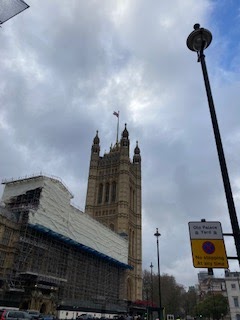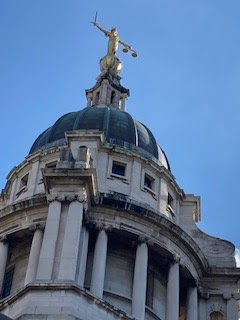This London Study Abroad trip featured a Criminal Justice theme, so no surprise that we spent a lot of time on touring London's legal sights. Students even had the opportunity to sit in on court cases in the public galleries, which is definitely educational if not that exciting. Certainly it could teach my Comp II students a thing or two about the importance of word choice - the case we sat in on mostly consisted of lawyers suggesting revision to their statements about a case of attempted murder as a joint venture. What language do you choose in order to suggest three people shared one gun?
We weren't actually allowed to take photos inside Parliament, other than here in this great hall at the opening. This is where they used to have big lavish feasts and banquets I guess, with eel and cock's comb and crayfish and stag's tongue and God knows what all, though they don't do that now.
Parliament from the outside.
Parliament from the outside.
I should note too that a couple of our students made it in the the MP question sessions they offer to the public...it was a memorable experience for them. We also had the opportunity to talk to an MP who stopped by to save his seat...a Scottish national named Chris Law who talked to us about a lot of subject including the importance of preserving democracy. He was very cool.
Wider view taken from Parliament Square outside.
This is also in the Hall at the entry...the light display you see is called New Dawn, a contemporary light sculpture by an artist named Mary Branson in honor of Women's Suffrage. The display is supposed to look like scrolls, and it changes to reflect "the ever rising tide of change that campaigners were certain would bring women the vote" (marybranson.com).
Big Ben kids!
Closer view of Big Ben in Parliament Square...
Wider view taken from Parliament Square outside.
This is also in the Hall at the entry...the light display you see is called New Dawn, a contemporary light sculpture by an artist named Mary Branson in honor of Women's Suffrage. The display is supposed to look like scrolls, and it changes to reflect "the ever rising tide of change that campaigners were certain would bring women the vote" (marybranson.com).
Big Ben kids!
Closer view of Big Ben in Parliament Square...
Below is down the road... the old horse guards getting ready for a parade.
This is the Supreme Court building, where the highest court in the UK meets...it's open to the public.
A wider view of the Old Bailey. The gold statue at the top is Justice, with her sword and scales.
We toured the Royal Courts of Justice as well, which was pretty cool, though again we could not take photos inside.
A wider view of the Courts, featuring the DMACC students waiting to start the tour.
In addition to many famous criminals who actually did something wrong, Oscar Wilde was also booked at Bow Street for "indecent acts," which is a BS charge related to being gay.
Definitely worth a visit, especially since Covent Garden is pretty cool and has a great weekend market.
Teacher's Note: All of this has value for Criminal Justice and British History obviously, but the court proceedings were a great lesson for Composition students working on argument, as I am sure the questions with MPs would have been as well. The importance of making careful language choices is demonstrated very clearly, and that's sometimes the hardest part to convey.

















No comments:
Post a Comment